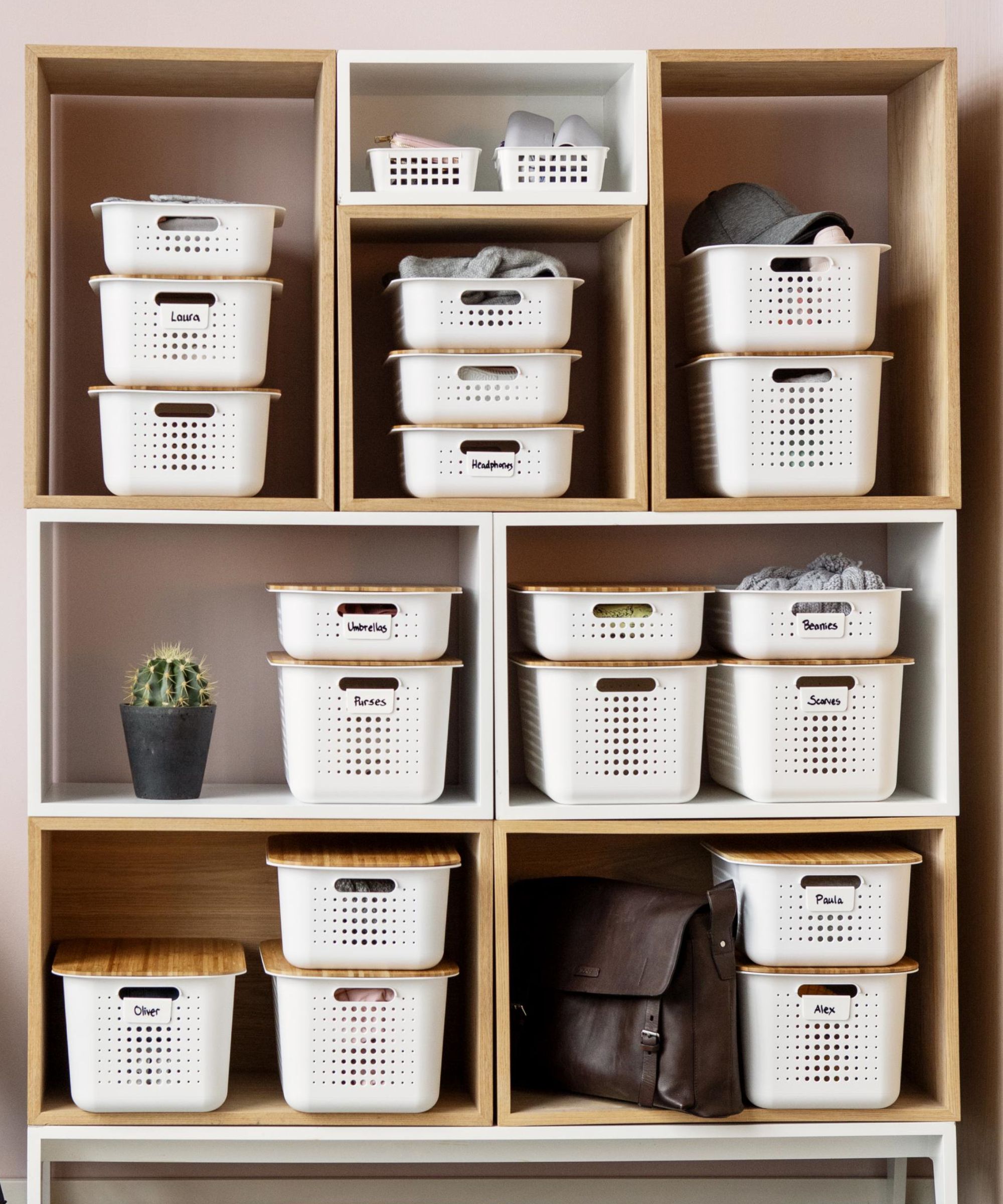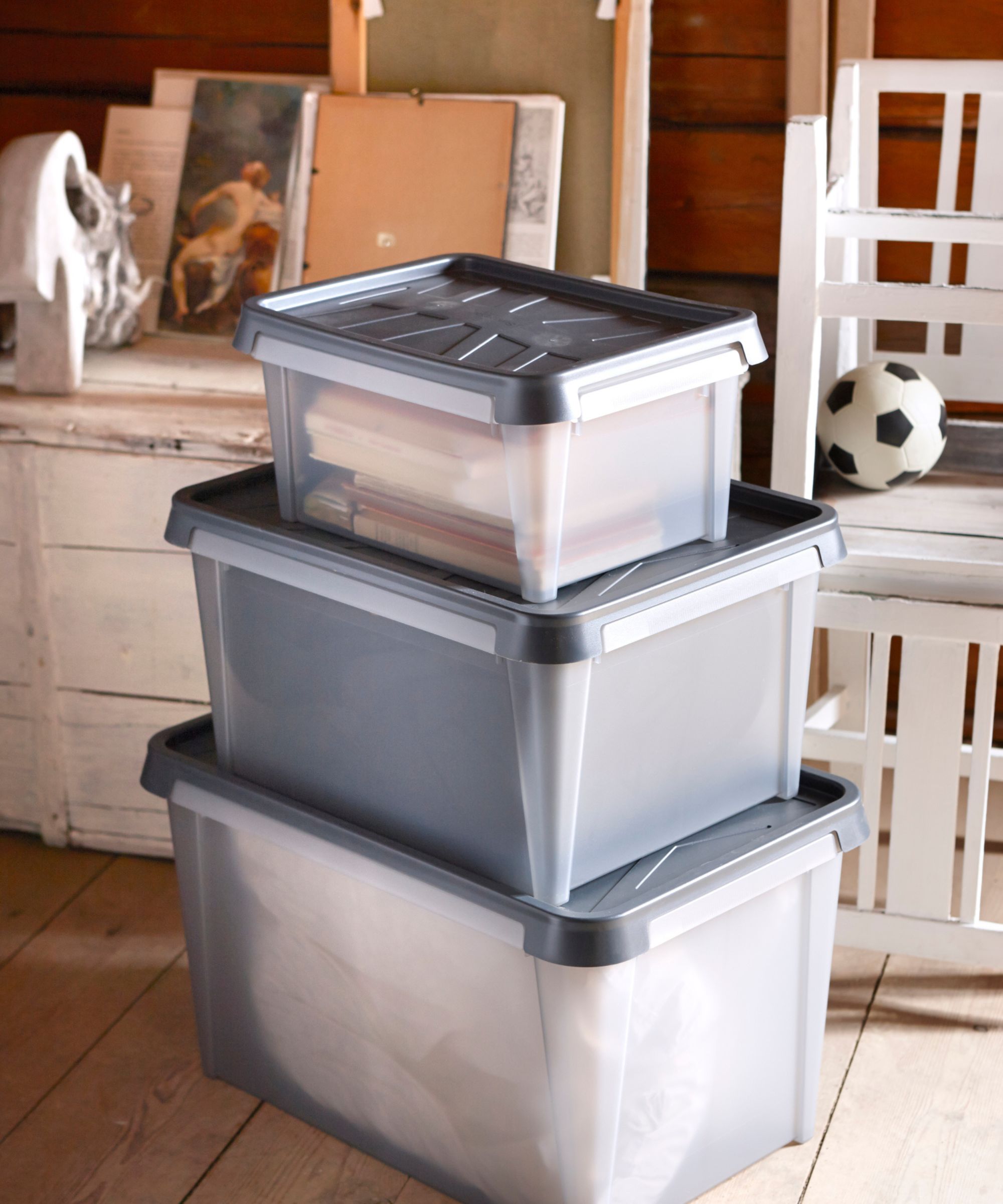Tips for storage in a small attic – how to protect your belongings and maximize space
How to organize a small attic to ensure it is storage-safe and efficiently utilized


Small attics are not always the most well-designed spaces, not only are they awkwardly shaped and hard to get into, but they often have a number of issues that mean they are not the safest place to store your treasured belongings.
For this reason, it's important to make your attic a place that is storage-safe. You should also be selective about what you store in your attic and how you do so to maximize space.
Our experts have provided some tips on how to sort and store items in this small space, as well as which items you should prioritize storing there to maintain an efficient and well-organized attic space, rather than a cramped dumping ground.
Tips for storage in a small attic
For homeowners who use their small attic for storage rather than as a living space, say an attic bedroom, it can be tempting to cram all your non-essential items into your space with little regard for the impact this will have on your home organization well as as the items themselves.
To make the most of this space and keep your home and items from being damaged, consider these expert tips for storage in a small attic.
1. Ensure your attic is storage-safe

Russell Palmer from water damage restoration company Orange Restoration warns that not all attics are the safest places to store our things: 'Often we find things in attics get destroyed by pests or water damage from roof leaks. Depending on the type of attic, you may want to refrain from storage in the attic before fixing any issues.
'Make sure storage does not make the attic unsafe. Check for any hazards already in the attic like pest waste before you decide to store belongings in the attic. If there is mold, pests or pest waste, disturbed insulation, or possibility of asbestos you will want to call an expert to do a professional cleaning job with health and safety in mind.' You can check out our guide for how to get rid of squirrels in the attic.
'Consider attic air sealing, this will keep your storage safe from water damage, pests and temperature variability,' continues Russell Palmer.
Tom Nolan, founder of home improvement company All Star Home points out that insulation is another important factor: 'How well is your attic insulated? If your attic isn't well insulated, you should consider sacrificing some storage space to add insulation to the space. Additional insulation will keep your items safe and is a eco home improvement that can help you save on heating and cooling costs.
'You also want to note how well the insulation is secured, or if it's exposed. Exposed fiberglass insulation can snag on your storage items, or get caught on fabric, making a mess. Also, are there exposed wires, outlets, or nails? You'll want to take time to cover these utilities up or avoid storing items on them.'
Top tip: Do not put weight on the drywall under the ceiling joists.

Tom Nolan is the founder of All Star Home, a home improvement company that helps individuals turn their house into the home of their dreams. As a home improvement expert, Tom is always looking for ways that people can live better in their homes, including minimizing clutter.
2. Organize

'Before you start storing items in your small attic, declutter ruthlessly,' advises Angela Rubin from Hellamaid. 'Take the time to sort through your belongings and donate, sell, or discard items you no longer need or use. This step will make it easier to organize and maximize the space.'

Hellamaid is an award-winning cleaning company in Canada that's been featured on multiple global media brands.
'Next, you need to assess what kind of items you want to store in your attic,' suggests Jacky Chou, founder of Archute. 'Typically, you should prioritize seasonal, sentimental, or practical items. Depending on which of these you want to store, you can choose different storage solutions that suit your needs.'
Angela Rubin reminds us to maintain accessibility when considering how to store items: 'Store frequently accessed items toward the front of your attic space, making them easier to reach. Avoid stacking heavy bins too high to prevent accidents when retrieving items.
'A small attic will be hard to move in, so when you plan to store items you'll need least often furthest from the door or hatch,' adds Tom Nolan. 'This might include infant keepsakes, wedding keepsakes, or even some holiday items. Then, move back towards the door, filling in the items you'll need most often last, so they are the easiest to reach.'

Jacky Chou is the Principal and Director at Archute, an editorial magazine about architecture, home and garden. They have been referenced by The New York Times, Bustle, House & Home, Bloomberg, and Angi. Jacky also his own an online interior design company as well called Laurel & Wolf.
3. Use space-saving storage solutions

Storage solutions for a small attic can be about more than organizing and maximizing space, they are also essential for protecting your items, ensuring they remain in pristine condition.
'For practical items, such as tools, crafts, or sports equipment, you want to store them in a way that maximizes the space and organizes them by category,' recommends Jacky Chou. 'A good idea is to use wall-mounted cabinets or drawers with labels and arrange them by frequency of use. You can also use baskets or bins to group smaller items, such as screws and buttons.'
Angela Rubin says, 'Opt for clear plastic storage bins with lids to keep your belongings visible and protected from dust and moisture. Label each bin clearly to identify its contents. Stackable bins are a great choice to save space.
'Installing sturdy shelving units or racks can make the most of vertical space in your attic. Adjustable shelves allow you to customize the storage to fit items of various sizes. Use the top shelves for less frequently accessed items.' You can check out our garage shelving ideas for sturdy shelving inspiration.
'Utilize under-eaves space,' continues Angela Rubin. 'This can be a perfect spot for smaller items, like books, photo albums, or shoes, that can fit neatly in low-profile bins or boxes.'
4. Items to prioritize storing in a small attic

When working with a limited attic space, it's crucial to prioritize items that you access less frequently but still need to keep.
Identify items that you don't use on a regular basis but still want to keep, such as camping gear, books and documents, or tools. Storing these items in your small attic can help declutter your living spaces while keeping them easily accessible when needed.
1. Seasonal items
You can make better use of the closet space in your living areas by storing your long-term clothes and items such as seasonal clothing, bags, blankets, and curtains in vacuum-sealed bags or labeled bins. If you don't ever rotate certain seasonal clothes out, it may be time to consider decluttering and donating them.
Holiday decorations, such as Christmas tree ornaments, lights, Halloween decorations and other items appropriate for the season can be stored in containers that are clearly labeled so that you can find them quickly whenever you need to.
2. Valuable items, keep sakes and memorabilia
'Small attics are excellent places to store memorabilia, sentimental items, and family heirlooms that hold sentimental value but aren't used regularly,' advises Hashi Mohamed, president of Ivy Cleans. 'This category can include old photographs, family albums, childhood keepsakes, and sentimental trinkets.
'Use archival-quality storage containers and acid-free materials to protect delicate items from deterioration.'
Jacky Chou suggests, 'For sentimental items, such as family photos, heirlooms, or collectibles, you want to store them in a way that protects them from dust, moisture, and pests.
'A good idea is to use acid-free boxes or albums with dividers and place them in airtight containers or chests. Alternatively, use vacuum bags or ziplock bags to seal delicate items, such as fabrics, papers, or books.'
We recommend these WEATHERPRO airtight plastic storage bin from Amazon, and this acid-free photo storage box, from Amazon.
'If you're storing fragile items, such as glassware or collectibles, wrap them in bubble wrap or packing paper and place them in bins with ample padding,' advises Angela Rubin. 'Stack these bins carefully to avoid breakage.'
3. Furniture and bulkier items
'Make the most of your small attic by storing larger items that you don't need for day-to-day living. This can include antique furniture, inherited pieces, or oversized items like mattresses, bed frames, and appliances,' says Hashi Mohamed.
'When storing furniture, cover it to shield against dust and potential temperature fluctuations. Ensure larger items are clean and properly wrapped or covered to prevent dust build-up and protect against potential pest infestations. By utilizing your attic for these items, you can free up valuable space in your main living areas.'
You can find bubble packing wrap, at Amazon.
4. Sports equipment
'If you or your family members are involved in sports, storing equipment in a small attic can be convenient and space-saving. Items like surfboards, golf clubs, and skiing gear can be safely stored away until they are needed again,' says Zach Shelley, founder of A-List Properties. 'Make sure to clean and properly pack these items, as well as any footwear or protective gear, before storing them in your attic.'
5. Travel gear
The attic can be an excellent spot for suitcases, travel accessories, and seasonal items, such as camping gear, which are typically bulky and used infrequently, freeing up closet space in main living areas.
'By prioritizing these types of items for storage in your small attic, you can maximize your available space, keep your cherished belongings safe, and maintain an organized storage area that serves your needs effectively,' says Hashi Mohamed.
FAQs
What can improve the air quality in my attic?
'If you live in areas with bad quality, such as Memphis, there’s a high chance that your attic has poor air quality,' says Steve Evans, owner of Memphis Maids. This can lead increase the likelihood of the development of mold.
'Even with small storage spaces, I would recommend an air purifier.' We suggest this AROEVE air purifier.
You can also add some lighting fixtures, such as lamps or motion-activated lights to improve visibility in your attic, making items easier to find. We recommend this motion sensor light, from Amazon.
'Make sure to check on your attic a few times a year to make sure pests haven't found a way in,' says Tom Nolan, 'Mice, rats and squirrels love finding home in an attic or crawlspace, compromising your storage items.'
Sign up to the Homes & Gardens newsletter
Design expertise in your inbox – from inspiring decorating ideas and beautiful celebrity homes to practical gardening advice and shopping round-ups.

Lola Houlton is a news writer for Homes & Gardens. She has been writing content for Future PLC for the past six years, in particular Homes & Gardens, Real Homes and GardeningEtc. She writes on a broad range of subjects, including practical household advice, recipe articles, and product reviews, working closely with experts in their fields to cover everything from heating to home organization through to house plants. Lola is a graduate, who completed her degree in Psychology at the University of Sussex. She has also spent some time working at the BBC.
-
 ALDI just restocked their smart-looking $4.99 self-watering planters for small container gardens, and it's the ideal solution for plant serial killers
ALDI just restocked their smart-looking $4.99 self-watering planters for small container gardens, and it's the ideal solution for plant serial killersThese highly-rated planters are perfect if you are time-poor, a novice gardener, or a frequent short-haul traveler
By Jennifer Ebert
-
 Diane Keaton's living room is proof that 'symmetry in interior design' is far from dated – this concept is still ingrained in our philosophy, but there's a twist
Diane Keaton's living room is proof that 'symmetry in interior design' is far from dated – this concept is still ingrained in our philosophy, but there's a twistSymmetry is a design trick used to create smart-looking spaces
By Jennifer Ebert